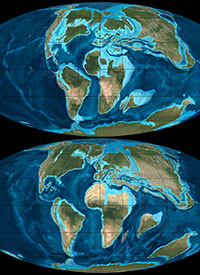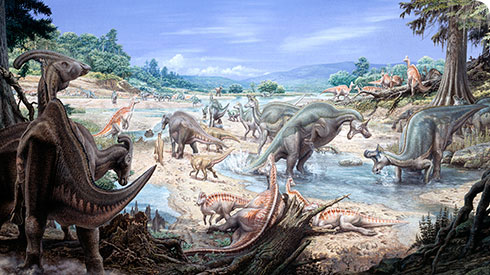End-Cretaceous mass extinction
After the end-Triassic extinction, with most large amphibians and mammal-like reptiles gone, there was an opening for a new dominant land animal. Dinosaurs soon filled this, becoming by far the most common animals in most land habitats.
But the Jurassic and Cretaceous Periods were not just the heyday of the dinosaurs. Flying reptiles, the pterosaurs, also diversified. And in the sea other reptiles - ichthyosaurs, mosasaurs and plesiosaurs - took on whale-like proportions.
This was also when flowering plants appeared, and the earliest birds evolved from a group of meat-eating dinosaurs, the theropods.
Then our most recent mass extinction changed Earth’s biodiversity again, and the reign of the dinosaur ended. But is there more to this famous story than you think?

Both pterosaurs (flying reptiles) and plesiosaurs (marine reptiles) perished in the end-Cretaceous mass extinction 66 million years ago. © John Sibbick, Natural History Museum
When did it happen?
66 million years ago.
What went extinct?
16% of all marine families, 47% of all genera, an estimated 71-81% of all species.
The most famous victims were the non-avian dinosaurs (birds live on today). Many other animal groups were also lost forever, including pterosaurs, ammonites and the spectacular mosasaurs and plesiosaurs. Plants and plankton were affected badly too.
A closer look at the fossil record reveals that many groups, including dinosaurs, were already on the decline millions of years before the main extinction event.

How the world looked 90 (top) and 65 (bottom) million years ago. The substantial drop in sea level drained many inland seas. © Ron Blakey, Colorado Plateau Geosystems, Inc
Causes
The end-Cretaceous mass extinction is famously associated with a large asteroid impact. While plenty of evidence shows at least one huge asteroid or comet slammed into Earth at this time, whether it caused or simply contributed to the extinctions is still hotly debated. Many palaeontologists think that the story is more complex.
Earth’s geography was transforming radically. As the land separated into some of the continents we know today, ocean currents and climate were changing.
Then, sea levels dropped significantly and rapidly, falling as much as 150 metres in less than 1 million years. Why this happened isn’t yet known. But it reduced large inland seas such as the Western Interior Seaway of North America, with a knock-on impact on terrestrial habitats, including those important for dinosaurs.
At the very end of the Cretaceous, intense volcanic activity rocked the planet. Even today the resulting basalt lava outcrop in India, known as the Deccan Traps, covers an area almost as big as France. Ash and toxic gases poured into the atmosphere, sending temperatures plummeting and causing acid rain. As plants perished, herbivores and their predators would have starved.

The intense volcanic eruptions that formed these basalt rock outcrops in India are thought to have contributed to the end-Cretaceous mass extinction alongside sea level changes and the famous asteroid impact. © Nicholas, CC BY-SA 2.5
These eruptions would also have ejected vast amounts of carbon dioxide. Scientists speculate that this caused ocean acidification, poisoning the phytoplankton (single-celled algae) that larger marine animals relied on for food.
Since these phytoplankton would normally remove carbon dioxide from the atmosphere (storing it as calcium carbonate in their skeletons), levels of this greenhouse gas were able to rise unchecked. Scientists estimate that temperatures may have increased by as much as 10°C, warming the oceans by up to 4°C and putting stress on species, particularly those already living in tropical areas.
It seems the volcanic eruptions and meteor impact were probably the final straw for species already suffering from the effects of sea-level changes.
Toolbox
The Great Extinctions book

What are the processes responsible for species extinction? And are we about to cause another mass extinction? Find out in this in-depth guide by Museum expert, Professor Norman MacLeod.
